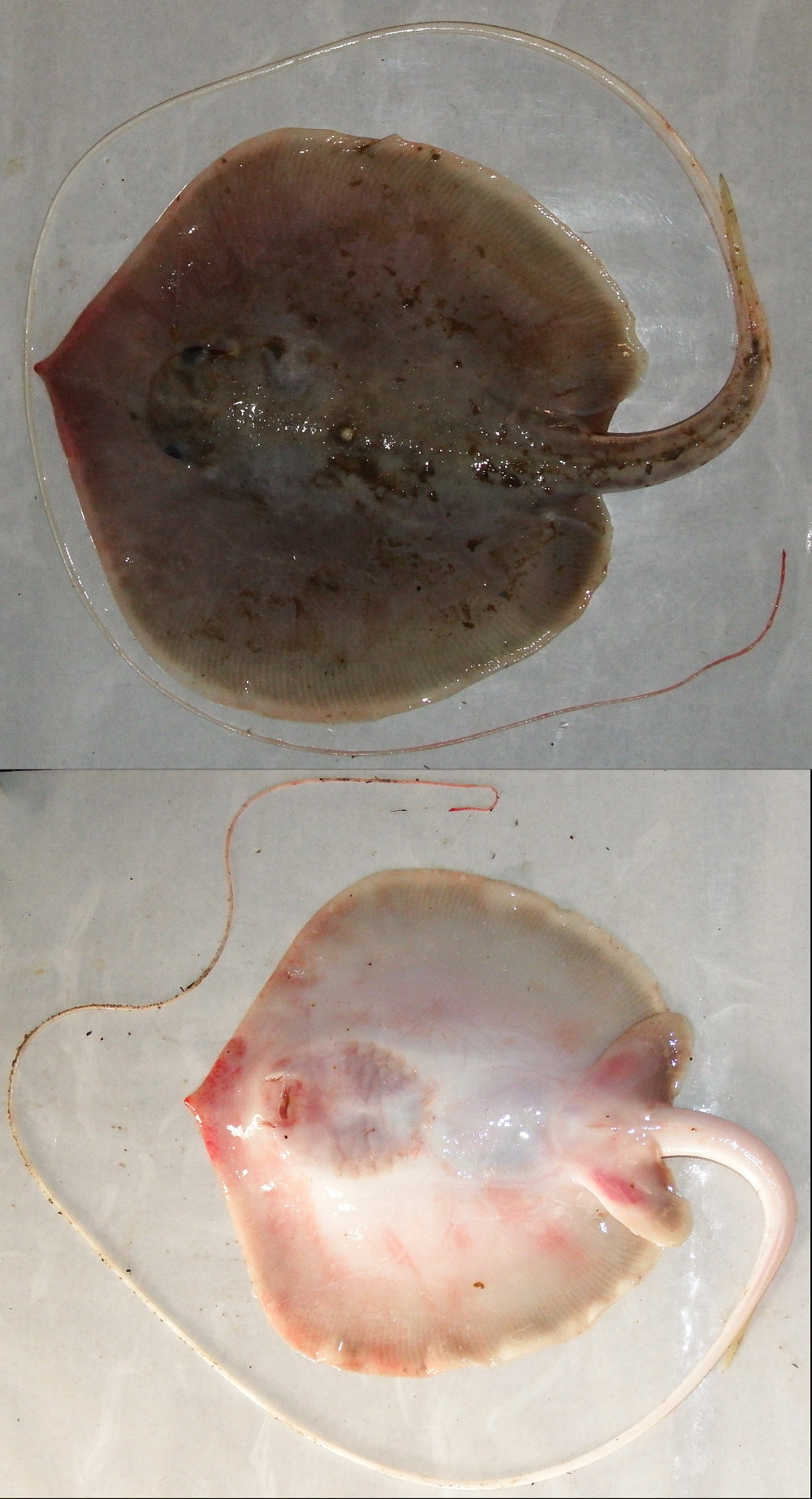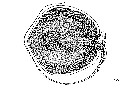Fluvitrygon signifer
(Compagno & Roberts, 1982)
White-edge freshwater whip ray
Classification: Elasmobranchii Myliobatiformes Dasyatidae
Reference of the original description
Freshwater stingrays (Dasyatidae) of southeast Asia and New Guinea, with description of a new species of Himantura and reports of unidentified species. Environmental Biology of Fishes, 7(4), 321–339
Freshwater stingrays (Dasyatidae) of southeast Asia and New Guinea, with description of a new species of Himantura and reports of unidentified species. Environmental Biology of Fishes, 7(4), 321–339
Image of the original description
Image in copyright.
Image in copyright.
Synonyms / new combinations and misspellings
Dasyatis signifer, Himantura cf. signifer, Himantura signifer
Dasyatis signifer, Himantura cf. signifer, Himantura signifer
Types
Fluvitrygon signifer
Himantura signifer
Holotype: MZB: 3004; Paratype: BMNH: 1981.11.16.1; CAS: 48777; MNHN: 1981-1342; MZB: 3005; RMNH: 28800; USNM: 229492;
Fluvitrygon signifer
Himantura signifer
Holotype: MZB: 3004; Paratype: BMNH: 1981.11.16.1; CAS: 48777; MNHN: 1981-1342; MZB: 3005; RMNH: 28800; USNM: 229492;
Description :
Citation: Fluvitrygon signifer (Compagno & Roberts, 1982): In: Database of modern sharks, rays and chimaeras, www.shark-references.com, World Wide Web electronic publication, Version 12/2025
Please send your images of "Fluvitrygon signifer" to info@shark-references.com

Fluvitrygon signifer (Compagno & Roberts, 1982), 5 March 2016 in Musi River basin, Palembang city, South Sumatra province © Muhammad Iqbal, Sriwijaya University, Indonesia

Fluvitrygon signifer (Compagno & Roberts, 1982), 5 March 2016 in Musi River basin, Palembang city, South Sumatra province © Muhammad Iqbal, Sriwijaya University, Indonesia
Common names
 Freshwater stingray,
Freshwater stingray,  Pale whipray,
Pale whipray,  White-edge freshwater whip ray,
White-edge freshwater whip ray,  White-edge freshwater whipray,
White-edge freshwater whipray,  White-rimmed stingray
White-rimmed stingray
 Freshwater stingray,
Freshwater stingray,  Pale whipray,
Pale whipray,  White-edge freshwater whip ray,
White-edge freshwater whip ray,  White-edge freshwater whipray,
White-edge freshwater whipray,  White-rimmed stingray
White-rimmed stingray
Short Description
Original diagnosis of COMPAGNO & ROBERTS, 1982 [545]: A Himantura with an oval disc, its medial lobe narrow-based and short; dorsal surface of disc mostly naked except for a sparse median band of small, flat heart-shaped denticles interspersed with scattered, small, conical denticles with scalloped bases (Fig. 7A); denticles present on tail posterior to stings but absent on snout and lateral portions of disc; pearl spine absent in large immature specimens and adults; two functional stings; eyes small, length of eyeball 2.0-2.8 times in interorbital space and 5.0-6.5 times in preorbital length; floor of mouth with four or five papillae, including a medial papilla of variable size (sometimes absent), a pair of large paramedial papillae (flanking medial papilla), and a pair of small lateral papillae opposite ends of dental band; total tooth rows 38-45 in upper jaw and 3846 in lower jaw; dorsal surface of disc, pelvic fins, and tail anterior to stings entirely white; tail posterior to stings a long, thin whiplash, its length about three and a half times disc width in specimens with intact tails; total pectoral radials 109-1 16; total vertebral segments 141-149; vertebral centra extending posteriorly to or beyond stings.
Original diagnosis of COMPAGNO & ROBERTS, 1982 [545]: A Himantura with an oval disc, its medial lobe narrow-based and short; dorsal surface of disc mostly naked except for a sparse median band of small, flat heart-shaped denticles interspersed with scattered, small, conical denticles with scalloped bases (Fig. 7A); denticles present on tail posterior to stings but absent on snout and lateral portions of disc; pearl spine absent in large immature specimens and adults; two functional stings; eyes small, length of eyeball 2.0-2.8 times in interorbital space and 5.0-6.5 times in preorbital length; floor of mouth with four or five papillae, including a medial papilla of variable size (sometimes absent), a pair of large paramedial papillae (flanking medial papilla), and a pair of small lateral papillae opposite ends of dental band; total tooth rows 38-45 in upper jaw and 3846 in lower jaw; dorsal surface of disc, pelvic fins, and tail anterior to stings entirely white; tail posterior to stings a long, thin whiplash, its length about three and a half times disc width in specimens with intact tails; total pectoral radials 109-1 16; total vertebral segments 141-149; vertebral centra extending posteriorly to or beyond stings.
Distribution
Asia: Indonesia, Malaysia and Thailand (Chao Phraya, Mekong and Tapi Rivers). Source: www.gbif.org
Asia: Indonesia, Malaysia and Thailand (Chao Phraya, Mekong and Tapi Rivers). Source: www.gbif.org
Human uses
fisheries: minor commercial; aquarium: commercial
fisheries: minor commercial; aquarium: commercial
Biology
Exhibit ovoviparity (aplacental viviparity), with embryos feeding initially on yolk, then receiving additional nourishment from the mother by indirect absorption of uterine fluid enriched with mucus, fat or protein through specialised structures [733]. Distinct pairing with embrace [17086]. Distinct pairing with embrace [17086].
Exhibit ovoviparity (aplacental viviparity), with embryos feeding initially on yolk, then receiving additional nourishment from the mother by indirect absorption of uterine fluid enriched with mucus, fat or protein through specialised structures [733]. Distinct pairing with embrace [17086]. Distinct pairing with embrace [17086].
Habitat
benthopelagic; freshwater; brackish
benthopelagic; freshwater; brackish
Dentition
Upper jaw with about 3-5 and lower jaw with about 4-8 functional tooth rows (probably increasing in number with growth). Teeth in quincunx pavement, rather loose-set, with crowns well-separated from one another. Teeth similar in upper and lower jaws, varying continuously lateral to symphysis, teeth largest and longest relative to width at or adjacent to symphysis and smallest and shortest near mouth corners. Upper dental band with a slight knob of slightly enlarged teeth at symphysis, separated by similar knobs on either side by depressions with :smaller teeth; lower dental band with a corresponding symphyseal depression into which symphyseal knob of upper dental band fits, and a pair of low lateral elevations which fit into depressions in upper dental band. Teeth of both jaws with high, peaked, broad-tipped, cuspless crowns shaped like mushroom caps; with a strong cutting edge or transverse keel and a strong basal ledge and concave, inset basal groove separating crown from root. Root small, high, and pedicellate, bilobed basally, and with a transverse groove and nutrient foramina. Dentition sexually dimorphic: teeth of male with higher crown and broad, transversely serrated, angular cutting edges; teeth of females with lower crown and blunter cutting edges offset by distinct labial and lingual edges. [545]
Upper jaw with about 3-5 and lower jaw with about 4-8 functional tooth rows (probably increasing in number with growth). Teeth in quincunx pavement, rather loose-set, with crowns well-separated from one another. Teeth similar in upper and lower jaws, varying continuously lateral to symphysis, teeth largest and longest relative to width at or adjacent to symphysis and smallest and shortest near mouth corners. Upper dental band with a slight knob of slightly enlarged teeth at symphysis, separated by similar knobs on either side by depressions with :smaller teeth; lower dental band with a corresponding symphyseal depression into which symphyseal knob of upper dental band fits, and a pair of low lateral elevations which fit into depressions in upper dental band. Teeth of both jaws with high, peaked, broad-tipped, cuspless crowns shaped like mushroom caps; with a strong cutting edge or transverse keel and a strong basal ledge and concave, inset basal groove separating crown from root. Root small, high, and pedicellate, bilobed basally, and with a transverse groove and nutrient foramina. Dentition sexually dimorphic: teeth of male with higher crown and broad, transversely serrated, angular cutting edges; teeth of females with lower crown and blunter cutting edges offset by distinct labial and lingual edges. [545]
Remarks
shark-references Species-ID=14642;
shark-references Species-ID=14642;

















